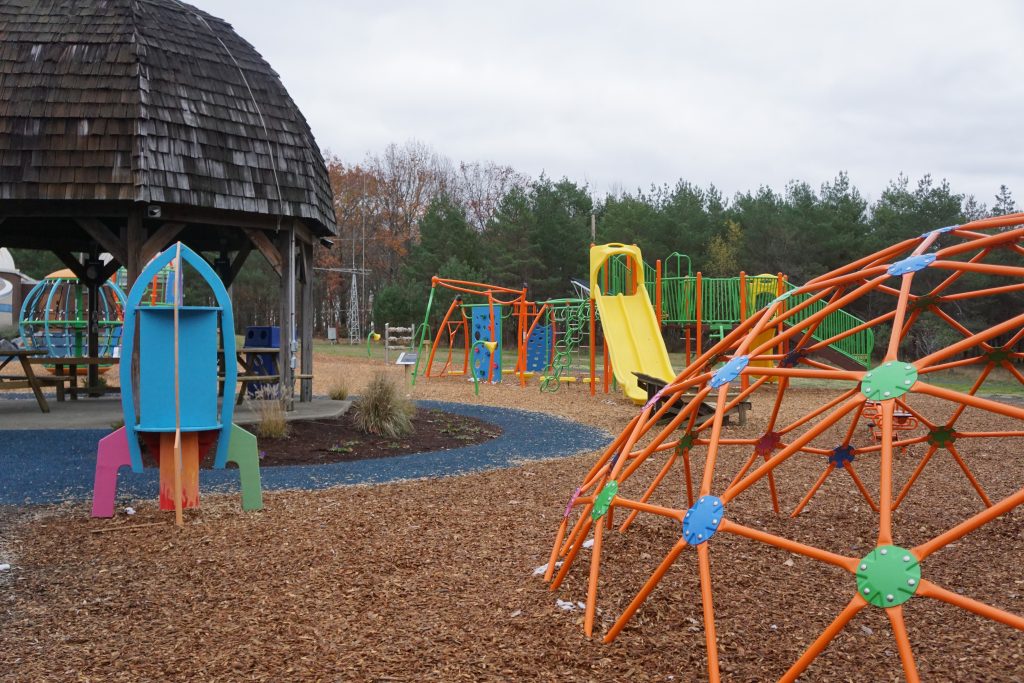After six years of planning, funding and community effort, the Kopernik Observatory & Science Center opened the Kopernik Science Park on the grounds of the observatory on Oct. 22.
The science park is set up like a traditional playground with slides, swings and a climbing wall. The park includes some special structures that were made with scientific concepts in mind. Visitors can read signs and use their phones to scan QR codes that correspond with certain structures and science lessons that explain how the structure works.
In an email, Andrew Deskur, executive director of the Kopernik Observatory, said he hopes the park will inspire visitors to examine everyday life through science.
“First and foremost, the Kopernik Science Park is a place where we can combine play and learning,” Deskur wrote. “Science and engineering are everywhere, and our hope is that, when families come to play at the Kopernik Science Park, it will inspire them to start asking questions — How and why does this work this way? Where can I find examples out in the ‘real world’ of the use of this concept?”
The creation of the science park started in 2014, when the Junior League of Binghamton, a nonprofit organization of women who promote voluntarism, came up with the idea as part of their spring Signature Community Project. The Junior League took on fundraising for the project while they helped Deskur develop designs. Construction began in 2019 with a state grant of $200,000 and various donations made for the park. The Broome County Legislature provided the Kopernik Science Park two grants, $30,000 in 2017 and $55,000 in 2019.
Deskur said Broome County Executive Jason Garnar and Legislature Chairman Dan Reynolds were instrumental in getting the funding that ultimately completed the fundraising that was needed to make the park. In addition to donations made by local foundations, corporations and private individuals, local members of the Boy Scouts of America and the Girls Scouts of the USA worked on projects that were integrated into the park.
“The signs for each play structure and content for the website was a Girl Scout Gold Award project,” Deskur wrote. “An Eagle Scout project is signage that shows the eight phases of the moon and are mounted on the eight pillars in our gazebo, and a group of Girl Scouts, for their Silver Award project, created a little library in the shape of a rocket blasting off.”
Once construction began, one of the challenges of creating the science park was the amount of bedrock just below the ground. Part of the park design was to deal with a natural spring that made a good portion of the play area a muddy bog. Deskur said the park design put drainage in the area of the spring that would run the water to a pond that would be an integral part of the park, but working with the bedrock slowed down the construction’s progress.
“The drainage of the spring made the playground area suitable for the play structures and the pond has become the home for frogs, dragonflies and other flora and fauna, which all showed up naturally,” Deskur said. “The bridge gives visitors an opportunity to look directly down into the pond to check out the animal and plant life. We took a liability and turned it into an asset.”
The COVID-19 pandemic also delayed the completion of the park when New York state put a hold on all nonessential construction projects in March. When the restriction was lifted, the final phases of the park were completed, which included installing the playground equipment and finishing up the landscaping.
For the time being, the Kopernik Observatory & Science Center is closed to the general public. The observatory has been offering livestreamed broadcasts on its YouTube channel, which have included coverage of rocket launches and landings of the SpaceX Crew Dragon mission with local astronaut Doug Hurley, telescope-observing sessions of comet NEOWISE and the Perseids meteor shower and the weekly Kopernik Friday Night Livestream, which covers a range of science, technology, engineering and mathematics topics.
While the facility remains closed, the park is open for the public to use and, according to Deskur, has been well received.
“I also love to hear the voices of the children playing in the park,” Deskur wrote. “Even during this time of social distancing, families are coming up to check out the park and the kids love it. We hope that once Kopernik [Observatory & Science Center] is able to reopen, the people who have ‘discovered’ Kopernik [Observatory & Science Center] through the Kopernik Science Park will engage in the classes, events and programs we offer.”
Deskur said Binghamton University alumni and students have helped with designing and creating the park, including a group of students from the Watson School of Engineering who helped design the bridge that spans the pond. He would like to see BU students continue to be involved in the future.
“I would love to see BU students get involved with helping us out with a number of projects,” Deskur wrote. “We could use some computer help, help with marketing and even setting up an online store.”



